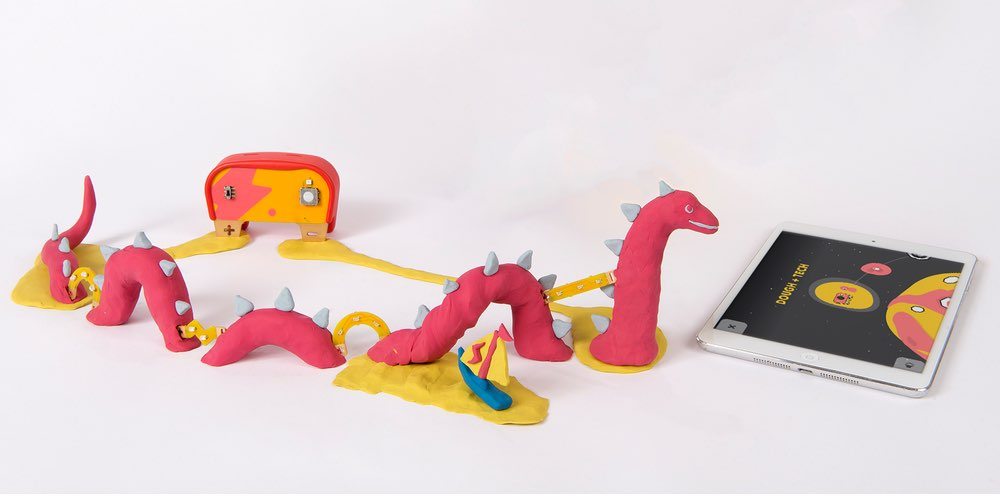Tech giant Dexter Ward is about to unveil the new TX-1 smartphone, and you’re here to report on it for your tech blog—never mind that you weren’t invited. Can you finagle your way past security for the big event? And what will you find behind the shiny facade of Techlandia?
What Is Techlandia?
Techlandia is a game for 1 to 4 players, ages 14 and up, and takes about 60–90 minutes to play. It’s currently seeking funding on Kickstarter, with a pledge level of $35 for a copy of the game. The gameplay is fairly straightforward and easy to learn; the theme is a mix of tech culture and Lovecraftian allusions, which seems to be the primary reason for the 14+ age rating.
New to Kickstarter? Check out our crowdfunding primer, and visit our Kickstarter curated page for more projects we love.

Techlandia Components
Note: My review is based on a prototype copy, so it is subject to change and may not reflect final component quality. Stretch goals may also affect the final component list.
- 12 Room tiles
- 12 Room cards
- 20 Gear cards
- 20 Encounter cards
- 8 Enemy cards
- 6 Lore cards
- Doomsday Clock
- 4 Player Dashboards
- 4 Player Character standees
- 6 Tech Cultist standees
- 1 Executive Cultist standee
- 4 QR Code Location markers
- 60 Marker cubes
- 4 QR Code cards
- 6-sided die
Some of the components in my prototype copy were 3D printed, like the QR code markers and the marker cubes (which are grey X tokens here), but will be replaced in the final version. The prototype also reuses artwork for most of the locations, but I believe each location will have its own artwork in the final version.

The artwork I have seen is pretty good, evocative of Apple’s shiny headquarters. As seen on the cover, there are some locations that are mostly blue and cheerful, and some with a red cast that have a more sinister tone. The location cards (which are just used when you need to choose a random location) have flavor text on them that’s pretty fun to read. Likewise, the gear and encounter cards also have a bit of flavor that’s a great mix of tech culture and unknown horrors.
Otherwise, the components themselves are fairly standard sorts of things: hex tiles, cards, and some oversized cards. It’s not entirely clear to me why some of the cards (the enemies and the QR codes) are oversized cards instead of regular-sized cards.
How to Play Techlandia
You can download a copy of the rulebook here, get a Print and Play, or try it out on Tabletopia.
The Goal
The goal of the game is to make it into the inner sanctum of Techlandia before the “Definitely Not a Doomsday Clock” hits 0.

Setup
Set up the map: you always have a column in the center with the Welcome Center, Security, Press Room, and Elevator. Then you randomly draw four more locations to place surrounding the Security hex—these rooms are rooms 1, 2, 3, and 4. Find all the relevant location cards (the Elevator is not represented by a card) and shuffle them together into a deck. The other location tiles and cards will not be needed.

Each player takes a character pawn and a player dashboard, which looks like a smartphone screen. Choose one of the three skills at the bottom of the dashboard and place a marker on it. Place your standee in the Welcome Center.
Shuffle the gear cards—players start with some number of gear cards, based on a die roll, and the rest of the cards are set nearby. The encounter cards, enemy cards, and QR cards are also shuffled in separate decks and placed nearby, along with the QR code markers and marker cubes. Place the Doomsday Clock nearby with a marker on 20. Finally, stack the lore cards next to the Doomsday Clock so that they’re in descending order (like a countdown).

Gameplay
To win, you must investigate all four numbered rooms, then collect 4 QR code fragments, and then present the correct security code at the Security room before heading to the Elevator before the clock hits 0. Defeating enemies will give you decryption keys, giving you multiple chances to get the right QR code.
On your turn, you may take up to 2 actions. Your options are:
- Move to an adjacent hex.
- Investigate a room.
- Pick up a QR code fragment from your current room.
- Fight an enemy in your room.
- Pick up a gear card in the Press Room (your hand limit is 5 gear cards).
- Submit your QR code in the Security room.
Using a gear card does not use one of your actions, nor does moving as a result of a gear or encounter card.
Here are a few details about some of the actions:
Investigate a Room
You must investigate each of the four numbered rooms once during the game (marking them on your dashboard when completed). To investigate, you must be in the room, and then roll a die: even numbers are success, odd numbers are failure. If you fail, you draw an encounter card and resolve it. (If you fail in a red room, you also have an additional penalty of losing an action on your next turn.) If you succeed, you draw two location cards from the deck: place a QR code marker in the first location, and place an enemy pawn in the second location.

Collect a QR Code Fragment
If you’re in the same room as a QR code marker, you may spend an action to collect it. Remove the marker from the board, and then put a marker cube on your dashboard to show that you’ve collected a QR code fragment. (The QR code marker is returned to the supply.)

Fight an Enemy
If there is an enemy in your room, you must use your next action to fight—you can’t just run away (unless you have the right gear). First, draw an enemy card from the deck, which shows the enemy’s combat rating, name, and a description. At the bottom is the enemy’s skill—if you have the same skill, you can block the enemy from using their skill on you, giving you 1 free re-roll. Roll the die; if you meet or exceed the combat rating, you win! Mark a decryption code on your dashboard, and remove the enemy from the board. If you fail, you take one “reality distortion” hit to your objectivity (marked on your dashboard), and you return to the Welcome Center.
Your objectivity, of course, is what keeps you from turning into a Techlandia fanboy, and the Tech Cultists have ways of swaying you to their side. If you take 3 hits to your objectivity, you become a fanboy until the next red number on the Doomsday Clock, and you’ll just interfere with the other players. Basically, if you move into a space with another player, they have to spend an action to kick you back to the Welcome Center before doing anything else. When the Doomsday Clock reaches the next red number, you come to your senses again, reset your objectivity, draw a gear card, and take regular turns again.

Submit a QR Code
Your investigations have turned up 4 QR code fragments, but you’re not entirely sure how to piece them together. Once you have all 4 fragments (and have investigated all 4 rooms), you may go to Security and use an action to submit your QR code. Draw a random QR code from the deck and scan it with your phone to find out if you’ve pieced them together correctly or not. If you fail, you may use a decryption code (obtained by defeating enemies) to draw again. With 3 decryption codes, you’ll draw all 4 cards, so you have guaranteed success.
If your code is accepted, you’ll need to make your way to the Elevator location before the clock runs out. If not, you’re busted and eliminated from the game.
Doomsday Clock and Lore Cards
After each player has taken a turn, advance the clock. Each time the clock reaches a red number, flip the corresponding lore card and read it aloud, and then follow its instructions. (Spoiler alert: bad things happen.)
Game End
The game ends either when a player has successfully pieced together a QR code and made it to the elevator, or when the Doomsday Clock reaches 0, whichever comes first.
Solo and Cooperative Modes
You can also play Techlandia by yourself, or cooperatively. For solo mode, if you lose a turn you just move the clock forward one space. If you get turned into a fanboy, discard all your gear cards, and skip ahead to the next red number, and then draw 1 gear card. For cooperative mode, players share a dashboard, so you can work together to investigate and collect the QR code fragments, but you also share an objectivity meter. Take 3 hits, and you’re done for.
Why You Should Play Techlandia
I think my favorite part of Techlandia is the writing: it’s a shame that in most gaming groups probably one player will read the rulebook and then teach the rest of the players, because there are funny asides and bits of story sprinkled throughout, sometimes giving some thematic background to gameplay and other times just to provide a little more of the atmosphere of the game. Designer Dan Ackerman has been a tech journalist himself for over a decade, and he imbues Techlandia with the best of the worst of it.
Some of this is expressed in the flavor text on the various cards that you’ll see throughout the game—locations, gear, enemies, and encounters. But the overarching plotline is in the lore cards, which are revealed gradually as the countdown clock approaches zero. It appears that the unveiling of the TX-1 smartphone isn’t just a big event in the tech world; there are strange things afoot… The concept for the game includes additional scenarios: the stretch goals include a prequel scenario and a final battle scenario if certain funding goals are reached.

The gameplay itself wasn’t quite as exciting to me. It’s pretty straightforward: run around, try to grab the QR codes, fight enemies when they’re in your space, and get to the elevator. A lot of it did feel like it was luck-dependent: without any gear, you’ve got a 50/50 chance of successfully investigating a room. Enemies range from 2 to 5 combat rating, so you have the luck of the draw for which one you’re fighting, and then some more luck to see if you defeat them. It’s possible to take a few turns getting to the press room and drawing more gear cards, but there’s no guarantee that you’ll get the gear you need for your particular circumstances, plus that countdown clock is always ticking.
There were a few things that I found odd (though some of these may change in the final game), like rolling a die to see how much gear you start the game with. It means that, right from the start, players may not be on a level playing field. I also noticed that the “Memes” skill is present only two enemies (and those with lower combat ratings), which means that it is unambiguously the worst choice. It seems strange that there isn’t any sort of balancing factor there—if you chose Memes and rolled poorly, you’re just at a disadvantage already. The overall difficulty of the game will also be influenced by the random selection of the four locations. Red locations are more difficult (costing you an action if you fail), so there could be a big difference between a game with 4 blue locations and one with 4 red locations. The first time I played a solo game, 3 out of 4 of the locations were red, and I ran out of time because I kept rolling poorly and losing actions.
The encounters also feel pretty swingy, particularly since they’re the penalty for failure and are also usually incorporated into the effects of the lore cards. There are good encounters that can give you benefits, though the majority of them are bad. It means that the luck of the draw can make a failure a much bigger consequence for one player than another.
There were also a few pieces that made sense to me mechanically but not thematically: for instance, the rule that you must investigate all four rooms before you can proceed. Thematically, you’re digging around and getting intel about where the QR code fragments are. But anyone can pick up a QR code that has been placed in a room—does that represent snooping on another player’s research? If you’ve already picked up all of the fragments without investigating all four rooms, why would you keep digging? Mechanically, it’s so that one player doesn’t get stuck doing all the work while the other player picks up all the codes: with everyone required to investigate four times, there are enough QR codes for everyone to pick up. But it really doesn’t fit the story.

Ultimately, I think your enjoyment of the game may hinge on how much you like the story that Ackerman is telling through the game. I don’t know if the gameplay is enough to sustain my interest after playing through all the storylines; I would prefer something that allowed for more strategy and planning and was less dependent on random chance. Personally, though, I liked the “Silicon Valley tech company with mysterious occult ties” storyline, and I’m curious to see where else it goes—whether the prequel and final battle are the whole story, or if there’s more beneath that aluminum-and-glass exterior.
For more information or to make a pledge, visit the Techlandia Kickstarter page!
Click here to see all our tabletop game reviews.
![]() To subscribe to GeekDad’s tabletop gaming coverage, please copy this link and add it to your RSS reader.
To subscribe to GeekDad’s tabletop gaming coverage, please copy this link and add it to your RSS reader.
Disclosure: GeekDad received a copy of this game for review purposes.






